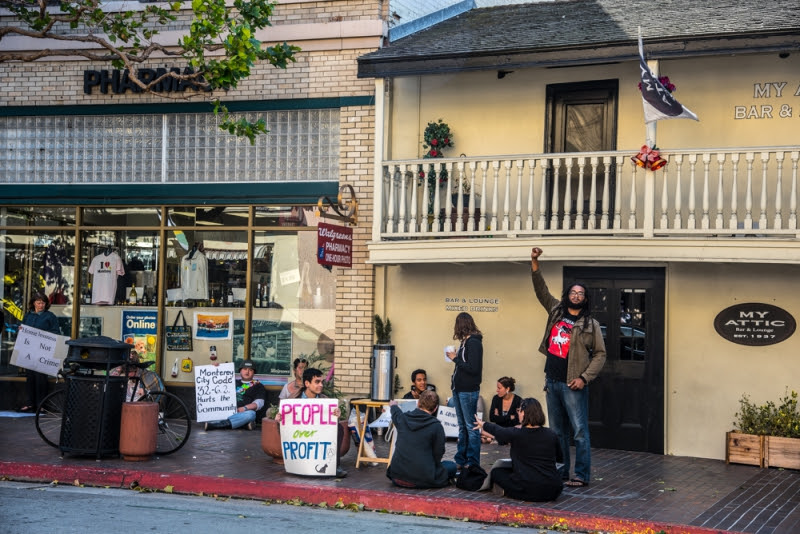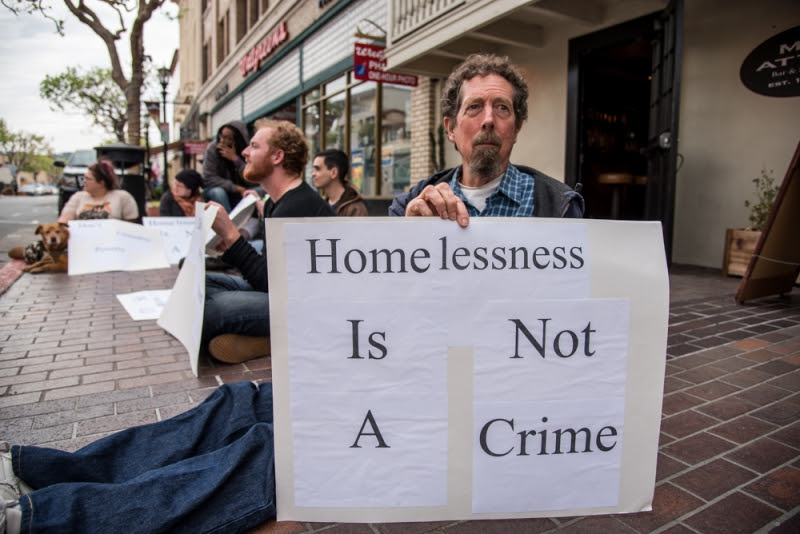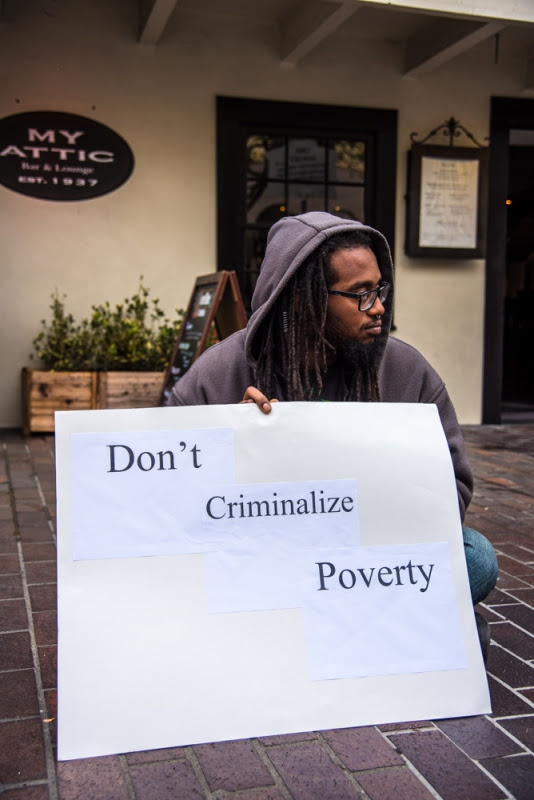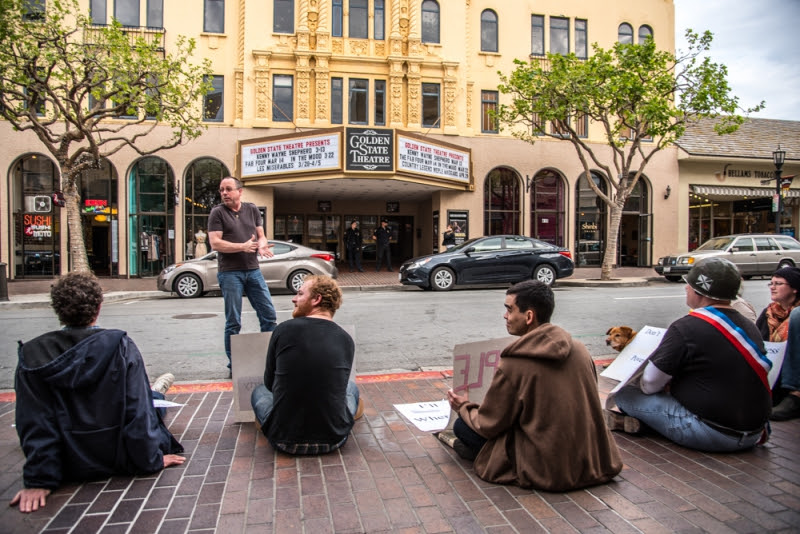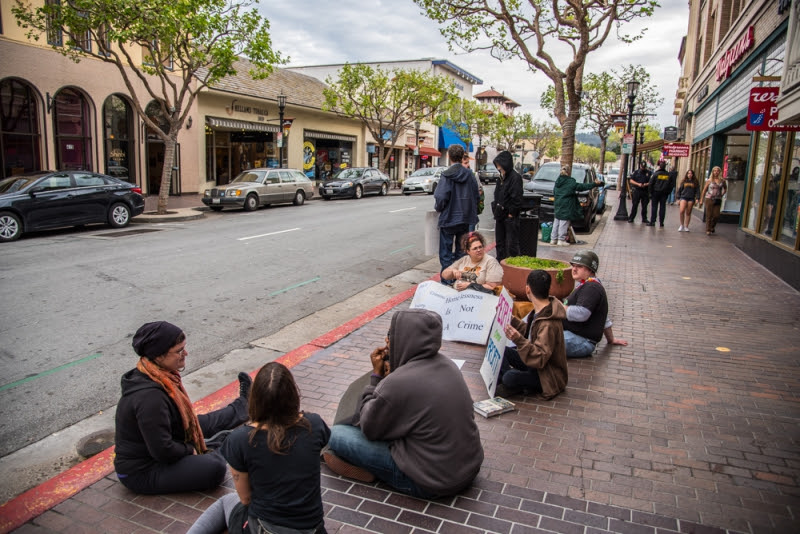Video at: http://theobamacrat.com/2015/05/07/brendon-glenn-aka-drizzle-29-year-old-unarmed-homeless-man-killed-by-police/
Brendon Glenn, aka drizzle, 29 Year Old UNARMED Homeless Man, Killed By Police
Mr MilitantNegro™
Jueseppi B

BREAKING: Witness Speaks Out On LAPD Police Murder
Published on May 7, 2015
In this video Luke Rudkowski is in Venice Beach California investigating the recent death of Brendon Glenn aka drizzle. Brendon was an 29 year old homeless man who was unarmed during the altercation with police. LAPD shot him two times and took his life.
From ABC7 Eyewitness News:
TRANSIENT MAN SHOT TO DEATH BY LAPD IN VENICE AFTER ‘DISTURBING THE PEACE’ CALL
By Marc Cota-Robles , Leo Stallworth and Jory Rand
A transient man was shot to death in Venice by Los Angeles police responding to a report of someone “disturbing the peace.”
The man, identified as Brendon Glenn, was described as a black male in his mid-to-late 20s. The officer who shot the suspect is also black, LAPD Cmdr. Andrew Smith said.

The shooting occurred near Pacific and Winward avenues around 11:30 p.m. Tuesday just a block or so away from the beach.
Two LAPD officers responded to the scene after people called police saying a man was causing a disturbance outside of a bar. Friends of the suspect say he was panhandling, but police said he was disturbing the peace.
After officers spoke with the suspect, he walked away in the direction of the boardwalk.
A short time later, the officers “observed the suspect physically struggling with an individual on the sidewalk west of their initial location,” LAPD said in a statement. The responding officers made contact with the suspect, and at some point, there was a struggle between the man and the two officers. That’s when the shots were fired.
The officer who shot the suspect, described by police as a veteran of the force, was on crutches after injuring his knee during the incident.
“Clap, clap, and I was like, ‘What was that?’ And all I see is this dude fall to the ground,” described Dylan Andre, a witness.
Andre was standing near the scene of the shooting, but he said he never heard or saw any scuffle before hearing the gunshots.
“When I heard the clap, it sounded like it came from far left, but it was right in front of me,” Andres said.
William Henson, a friend of the suspect, said the man was still alive and asking for help after he was shot. The suspect was transported to an area hospital, where he was pronounced dead shortly after midnight.
Henson described the man as a lost soul.
“He was a recovering crackhead for 13 years, came out here, got real bad on alcohol, but if he wasn’t on alcohol, he was OK,” Henson said.
Don Wige, who lives on the streets, also knew the suspect.
“He had a lot of anxiety inside of him and frustration. He couldn’t understand why the world was so negative,” Wige said, adding that the suspect’s size and strength could easily look threatening.
“But then again, that’s not a reason to kill somebody because they look threatening,” Wige said. “They could have shot him in the arm. They could have Tasered him. They have so many options to handle the situation, but they immediately go to the extreme which is the gun.”
LAPD Officer Meghan Aguilar said police protocol is to use the least amount of force necessary to control the situation. She said she doesn’t know why a Taser was not used in the incident.
“That will be something that force investigation division does ask the officers. They will ask them why they chose to use the force they did and why they didn’t choose to use the force that they did not use,” Aguilar said.
The two officers involved in the shooting were not wearing body cameras, and there was no dash camera on their vehicle. However, police said they will retrieve surveillance video from the surrounding area that they believe captured the shooting.
LAPD Chief Charlie Beck spoke at a news conference held Wednesday afternoon and said surveillance video shows the officer and suspect in a scuffle. He also said the department will thoroughly investigate the situation.
“Anytime an unarmed person is shot by a Los Angeles police officer it takes extraordinary circumstances to justify that, and I have not seen those extraordinary circumstances at this point,” he said.
The injured officer is on medication and has yet to be interviewed by investigators about the shooting, Beck said. Both officers involved in the shooting have been taken off the street and will remain off patrol pending the outcome of the investigation.
Authorities said a suspect weapon was not found at the scene. The shooting remains under investigation.
Beck said a town hall meeting is scheduled at the Pacific Division Station involving the LAPD and political leaders on Thursday.
Thank you Marc Cota-Robles , Leo Stallworth and Jory Rand & ABC7 Eyewitness News

From KTLA5:
LAPD Chief Beck: No ‘Extraordinary Circumstances’ to Justify Venice Fatal Police Shooting
LAPD Chief Charlie Beck on Wednesday addressed the death of an unarmed homeless man fatally shot by an officer following a confrontation near the historic Venice sign, saying the shooting concerned him and an investigation was underway.
Brendon Glenn, 29, was the individual killed by police late Tuesday night, according to a man who runs the Teen Project’s drop-in center for homeless youth in Venice.
Beck said in a Wednesday afternoon news conference that he had reviewed video of the shooting and he did not see evidence that indicated extreme circumstances that could prompt an officer to open fire.

“Any time an unarmed person is shot by a Los Angeles police officer, it takes extraordinary circumstances to justify that, and I have not seen those extraordinary circumstances at this point,” Beck said.
Both the male officer who opened fire and the man killed were black, the chief noted.
“Even if race is a small part of this, which I don’t think it is, they’re certainly outweighed by the mental health issues, the homeless issues, the alcohol issues,” Beck said. “All of those things … have nothing to do with a person’s race.”
The incident began about 11:20 p.m. Tuesday when someone called police to report a man harassing customers and refusing to leave near Pacific and Windward avenues (map), Beck said.
The location is about a block away from Venice Beach and in front of several bars and restaurants.
The man, described as a transient, had been involved in an altercation with a bouncer at a nearby bar prior to police being called, LAPD Detective Meghan Aguilar initially said Wednesday morning. Police were called with a report of a man “disturbing the peace” and “harassing passersby,” she said.

Brendon Glenn, fatally shot by LAPD on May 5, 2015, in Venice, is shown in a photo provided to KTLA.
Officers spoke with the man, who then walked away toward the boardwalk, Beck said. Soon after, officers saw the man approach an individual and start a fight, the chief said.
“The officers attempted to detain the suspect, and an altercation occurred between the two officers and the suspect. During that physical altercation, an officer-involved shooting occurred,” Beck said.
Officers called for a rescue ambulance and began to perform CPR; city firefighters responded and took the man to a hospital, where he died, according to the chief.
A friend who knew Glenn said he didn’t deserve his fate.
“Whatever reason that they had to shoot him, I don’t think it was justified because he wasn’t a confrontational human being by any means,” local resident Henry Geller said. “He was definitely like a peacemaker.”

A make-shift memorial was set up Wednesday in memory of an unarmed 29-year-old homeless man who was shot and killed by police on May, 5, 2015. (Credit: KTLA)
Another friend, Shane Brigham, described Glenn as “a really big hugger,” who always checked to make sure everyone around him was alright.
Glenn was a regular the Teen Project’s the P.A.D., a Venice support center for homeless youth, according to Timothy Pardue, who runs the center. Glenn, who had recently moved to the area from New York, had come to a support group meeting on Tuesday night, Pardue said.
“He was crying and he was even saying he wanted his mom, and he just said his mom didn’t want him back home,” Pardue said. “He struggled with a lot of things.”
As of Wednesday evening, the coroner’s office had not confirmed the fatally shot man’s identity. Beck said the man’s identity was not being released pending family notification.
During the struggle that led to the shooting, one of the LAPD officers was injured and later treated for a hurt knee, Aguilar said.
The injured officer, who was the open who opened fire, was on medication and had not been questioned because the medication could interfere with a “fair” interview, Beck said. He noted that the delay was unusual.
“I know there are public concerns about this particular officer-involved shooting, as there are any time an unarmed individual is shot by a police officer. I am also very concerned about this shooting,” Beck said. “We will expend all resources to find out the truth of what happened last night on Windward Avenue.”
As the investigation into the incident continued, the intersection of Pacific and Windward was cordoned off and closed to motorists. Investigators were trying to obtain surveillance video from businesses, police said.
Neither officer involved was wearing a body camera, Aguilar said, noting that the camera program had not yet been expanded to include all officers.
Both officers involved in the shooting were assigned nonfield duties during the ongoing investigation, Beck said.
The police officers’ union president said Beck’s statements would unduly influence the investigation.
“It is completely irresponsible for anyone, much less the chief of police, to render a judgement on an incident that is in early stages of investigation,” said Craig Lally, president of the Los Angeles Police Protective League, in a written statement. “As the final trier of fact in the use-of-force investigation and disciplinary process, the premature decision by the chief essentially renders the investigation process void.”
A “town hall” meeting was set to be held Thursday in connection with the shooting, according to the chief.
Thank you KTLA5 & TRACY BLOOM, MARK MESTER, MELISSA PAMER, COURTNEY FRIEL AND MARY BETH MCDADE

Unarmed Homeless Black Man Fatally Shot By Police
Los Angeles Police Chief Charlie Beck said Wednesday he has yet to see evidence that would justify one of his officers killing an unarmed homeless man in Venice Beach Tuesday.
Beck cautioned that his department’s investigation was just underway but told reporters he was ‘very concerned’ by the deadly shooting that occurred as an officer struggled with the man on a block lined with bars and restaurants.
‘Any time an unarmed person is shot by a Los Angeles police officer, it takes extraordinary circumstances to justify that, and I have not seen those extraordinary circumstances at this point,’ Beck said.
Department investigators have not interviewed the officer, a veteran of the LAPD, because he is on medication to treat a knee he hurt during the struggle. He was observed at the crime scene Wednesday walking on crutches.
The officers were not wearing body cameras, but police have surveillance footage from nearby stores that shows the altercation, Beck said.
The confrontation began at 11.30pm at Pacific and Winward avenues when two officers responded to a 911 call saying the man, an African-American vagrant in his 20s, had been arguing with a bouncer who would not let him into the popular Townhouse & Del Monte Speakeasy bar and was pestering passersby, police said.
The officers spoke to the man, identified by an acquaintance as 29-year-old Brendon Glenn, who began walking away but then came back and began struggling with someone on the sidewalk, according to a police news release.
The officers tried to detain Glenn, who was shot during the struggle, police said. The cops called for an ambulance and then began performing CPR to revive the suspect.
The 29-year-old was rushed to an area hospital, where he died from his wounds a short time later. No weapon was recovered at the scene, police spokeswoman Liliana Preciado said.
William Henson, a friend of the slain vagrant known to his friends as ‘Dizzle,’ said he was a recovering crack-cocaine addict and alcoholic.
Don Wige, who also lives on the streets of Venice Beach, told the station KABC the officers may have been threatened by his friend’s size and physical strength.
‘But then again, that’s not a reason to kill somebody because they look threatening,’ Wige said. ‘They ‘would have shot him in the arm. They could have Tasered him. They have so many options to handle the situation, but they immediately go to the extreme which is the gun.”
On Wednesday, a small crowd of people shouted at police in Venice Beach. Beck later noted that the officer and Brendon Glenn were black.
‘Even if race is a small part of this, which I don’t think it is, they’re certainly outweighed by the mental health issues, the homeless issues, the alcohol issues,’ Beck said.
Those who knew Glenn said he had moved to LA from New York City only a couple of months ago and had been struggling to find a job.
Timothy Pardue, who runs a local center that provides assistance to homeless youth, told KTLA that Glenn was one of his regulars.
Pardue said Glenn showed up at Teen Project’s PAD center Tuesday night, just hours before his death; he was crying and lamenting that his mother would not let him come home.
Glenn’s many acquaintances among Venice Beach’s large transient community told the LA Times that the recent East Coast transplant had an aggressive – even mean – side to him, but he also had been known to hug people and tell them he loved them.
The LA police department will hold a ‘town hall’-style meeting in the neighborhood Thursday to address the shooting.
The department was criticized after an officer fatally shot a homeless man in March on Skid Row, near downtown LA.
Neither police nor the coroner’s office had confirmed the dead man’s identity, though Preciado said a 911 caller and several witnesses identified him as one of the Venice area’s many transients.
Councilmember Bonin Calls People of Venice Outraged by Police Murder “Outside Agitators”
by Los Angeles Peoples Media Friday, May. 08, 2015 at 10:45 AM
During a Venice Town Hall meeting, Los Angeles City Councilmember Mike Bonin explained to 35-year Venice Beach resident David Busch that he is willing to talk to unhoused persons individually, but Mr. Bonin refuses to meet with “activists—outside agitators.” Mr. Busch has been requesting a meeting “organized by homeless people themselves” regarding public toilets, parking, camping, and other services. He asked, “Don’t you think after 2 years in office it is time you meet with us, rather than you just sending more police to this community?”
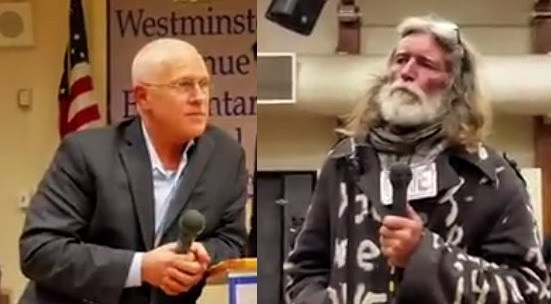
bonin_v_busch.jpg, image/jpeg, 551×304
If you vote, remember that Councilmember Mike Bonin called people who are outraged at cops murdering people, “outside agitators.”
At Thursday’s LAPD community meeting in Venice following the fatal shooting of unarmed 29-year-old Brendon Glenn, also known to friends and the Rainbow Family as Dizzle, community members took the microphone for public comment.
David Busch, who first moved to Venice in 1980 to work as a bus mechanic for the transit system but has been priced out of the housing market in recent years, noted that police “shoot to kill disproportionately poor people. Sixty percent of the people in Los Angeles really can’t afford, by any major economist’s point of view, more than $400-500 a month in rent. Don’t you think…you should be at the forefront of housing people instead of just sending the police after them?”
Busch first became homeless in 1994—and was sentenced to 120 days in Orange County Jail—for “refusing to be coerced into a shelter that made you sit through religious sermons before they would give you a bed or feed you.” He explained after the meeting, “I have slept ‘outside’ on the streets ever since—rather than bow down to such increasing human rights violations here in America.” For six years now, Bonin has played a role in “denying over 300 homeless people here in Venice their fundamental human right to a humane toilet.”
He addressed Councilmember Mike Bonin at Thursday’s town hall meeting: “Last year a group of us who are homeless contacted your office and asked for a meeting with homeless people. Your staffer, after three phone calls, this was last year before Christmas, he laughed. He said you are not meeting with people who are homeless. Except for meetings that are organized by religious leaders.”
Busch grilled Bonin: “Where is the toilet? Where is the camping place? 6 years ago you stood with Bill Rosendahl in this place and said we were going to get toilets, we were going to get services, we were going go get RV parking. Where have you done that? You’re standing here. I want an answer. We want results.”
Voices from the crowd echoed: “We all want answers!”
Bonin’s answer: “I meet and talk to people who are unhoused every week. I have met with people on 3rd Ave. I have sat and spoken with people on Ocean Front Walk. I have met with people in St. Joseph’s Center. I have met with people who are sleeping outside my office in Westchester. I have met with people at the Winter Shelter. I have met with people who live on the streets near the VA. I do it all the time. What I’m not going to do is take a meeting organized by activists—outside agitators who are trying to..”
At this point, the room crowd erupted in outrage at the slur just uttered by elected representative Mike Bonin.
Before handing the microphone to the next person in line, Busch declared, “Maybe we should stop talking to politicians. How many times have I asked you for a toilet?”
For the record, David Busch has “lived on the streets in Santa Monica, Skid Row and Venice since 1996. I’ve lived on the streets here longer than Mike Bonin has been HOUSED on the Westside.”
SEE VIDEO [3:45 length]
David Busch vs. Mike Bonin by The Syndicate.Info
http://www.youtube.com/watch?v=CQsWAiKfgFk Continue reading →
